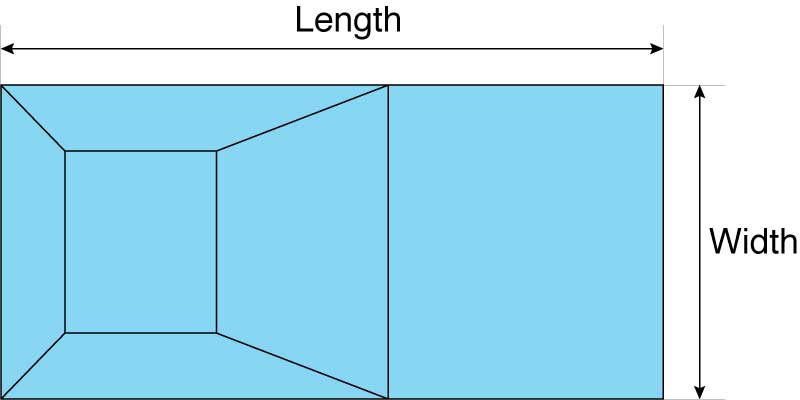Pool Volume Calculator
Results:
Gallons:
Liters:
Cubic Feet:
Results:
Gallons:
Liters:
Cubic Feet:
How to Calculate Pool Volume
If you’re here, then there’s a good chance you’re trying to find the size of your pool in gallons or trying to figure out how much water is needed to fill it. Keep reading to see the volume formulas for various pool shapes.
How to Calculate Rectangular Pool Volume

You can find the volume of a rectangular swimming pool in gallons by multiplying the length by the width by the average depth in feet by 7.48. The formula to find pool volume in gallons is thus:
How to Calculate Circular Pool Volume

You can calculate the volume of a circular swimming pool by multiplying 3.14 times the radius squared times 7.48. Thus, the formula is:
The first part of this formula (πr2) determines the area, and multiplying by the depth finds the
volume. Multiplying by 7.48 finds the gallons of water per cubic foot of water.
Your pool’s radius is 1/2 of the diameter. So if your pool is 10 feet wide, the radius is 5
feet.
To get the radius squared, multiply 5 feet by 5 feet, giving you 25 feet. If your average depth
is 4 feet, then your volume formula will look like:
How to Calculate How Many Plants You Need
The first step to finding how many plants or flowers you need is to select a pattern you would like to use when planting them and choose the spacing between each plant. Plants may be put in a rectangular or a triangular grid and estimating the plants needed for each pattern is a bit different.
Rectangular Planting Grid
To plant flowers in a rectangular pattern, place each in parallel rows and columns in a grid.
Start by dividing the landscape bed into squares that are the width and length of the desired
spacing, then add a plant at each corner of the square.
To estimate how many plants are needed, find the number of rows and columns and determine the
spacing between each.
Steps to Estimate Plant Spacing for a Rectangular Grid
First, measure the landscape bed length and width in inches. Use our feet to inches conversion
tool to convert a measurement in feet to inches.
Divide the width by the spacing to get the number of columns then divide the length by the
spacing to get the number of rows.
Finally, multiply the rows by the columns to find the number of plants needed.
Triangle Planting Grid
Planting flowers in a triangle pattern is a little bit different. It involves offsetting each row
so that the plants are at a 45° angle to each other.
To plant using the triangle pattern, divide the landscape bed into a series of equilateral
triangles with the edges of the triangle the desired spacing. The rows will be offset or shifted
by about half of the spacing length and will be closer together since the spacing will be at an
angle.
Steps to Estimate Plant Spacing for a Triangle Grid
To estimate the number of plants needed, measure the length and width of the landscape bed in
inches.
Then, divide the width by the plant spacing to find the number of columns.
Since the plants are at an angle to each other, the spacing between the rows will be shorter.
Use the following formula to find the spacing between rows:
To find the number of rows simply divide the length by the row spacing.
Finally, multiply the number of rows by the number of columns to find how many plants are
needed.
Check out our soil calculator to estimate soil for your plantings and our mulch calculator to
find how much mulch you need for your landscaping.